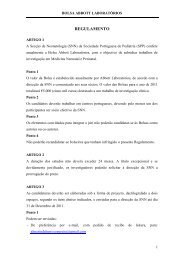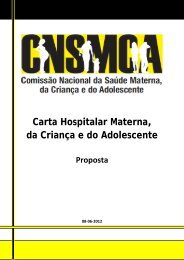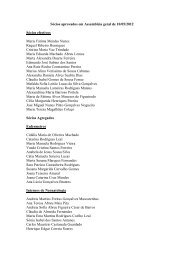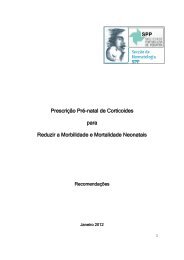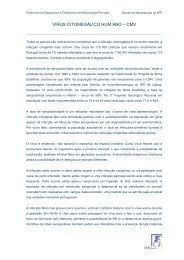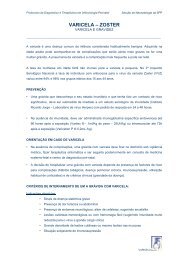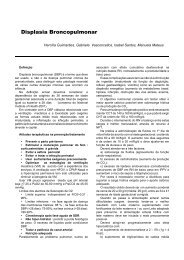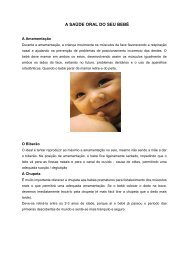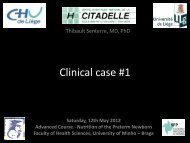You also want an ePaper? Increase the reach of your titles
YUMPU automatically turns print PDFs into web optimized ePapers that Google loves.
PRETERMMETABOLIC BONE DISEASENeonatalChildhood
Metabolic Bone DiseaseOsteopeniaDecrease in organic bone matrix (osteoid): thickness or number oftrabeculae or thickness of bone cortex‣ bone mineral content (BMC) (mass of mineral per unit length)OsteomalaciaDecrease in mineralization of organic bone matrix accumulation ofnonmineralized bone matrix and softening of bones.‣ BMC plus bone mineral density (BMD) (ratio of BMC to bone area)Vachharajani. NeoRev 2009
‣ PRENATAL‣ POSTNATAL - NICU‣ POSTNATAL - POSTDISCHARGE
PRENATAL
Nutrição ósseaIntrauterine nutrition3 compartment modelCetin. Ann Nestle 2010
Bone nutrition last trimester>24 weeks: mineral transference with peak of:<strong>Ca</strong> (active transport) 120-150 mg/Kg/d (~ 13-16 ml/Kg/d of <strong>Ca</strong>gluconate 10%)P 60-75 mg/Kg/dMg 2.5-3.4 mg/Kg/dMineral transference - dependent on maternal <strong>Ca</strong> and vitamin D statusVachharajani. NeoRev 2009, Velaphi. S Afr J Clin Nutr 2011
Bone nutrition last trimesterMaternal <strong>Ca</strong> intake Low intakes (
Bone nutrition last trimesterMaternal vitamin D statusProspective study on 424pregnant women:Maternal vitamin D insufficiency can influence fetal femoraldevelopment (high resolution3D ultrasound) as early as 19weeks’ gestation Mahon. J Bone Miner Res 2010
Bone nutrition last trimesterMaternal vitamin D statusCohort on 198 children born in UK, evaluated at age of 9 years: Maternal use of vitamin D supplements associated with greaterchildhood bone mineral mass Very low maternal concentrations of serum 25-hydroxyvitamin D associated with lower bone mineral mass in the offspringJavaid . Lancet 2006
Bone nutrition last trimesterEndocrineenvironmentPTH / PTHrPGH/IGF axis T 3 vit D 3<strong>Ca</strong>lcitoninEstrogenCooper. Nestlé Nutr Workshop Ser 2008, Vachharajani. NeoRev 2009
Bone nutrition last trimesterEndocrine environmentThe fetus is maintained hypercalcemic in a high calcitonin andestrogen environment promoting the modeling/ remodeling ratioin favor of modeling increasing the endocortical boneRigo. J Pediatr 2006
Bone nutrition last trimesterOther factors Mechanical stimulation – regular fetal kicks against the uterine wallRauch. Arch Dis Child F&N Ed 2002 Parental height Harvey. J Clin Endocrinol Metab 2008 Chorioamnionitis, preeclampsia Vachharajani. NeoRev 2009
Bone nutrition last trimesterOssification‣ Intramembranous (skull,face)‣ Endochondral (remainingskeleton)Cooper. Nestlé Nutr Workshop Ser 2008,Velaphi. S Afr J Clin Nutr 2011
Bone nutrition last trimesterEndochondralThe osteoblasts form theprimary trabeculae bydepositing an osteoid matrixbone growth occurs byreplacement of the cartilaginouscoreCooper. Nestlé Nutr Workshop Ser 2008Vachharajani. NeoRev 2009
POSTNATALNICU
Protein nutritionof the matrix
Bone nutrition preterm infantNUTRIENTS Energy e protein: collagen of the matrix Minerals: <strong>Ca</strong>, P, Mg Vitamin DRauch. Arch Dis Child F&N Ed 2002; Rigo. J Pediatr 2006
Protein and Energy
IUGR and EUGRVLBW infants (
IUGR and EUGRVLBW infants (
Short term: AA + energy weight gainRCT 125 neonates
Nitrogen Balance(g/kg/d)Short term: early high AA nitrogen balanceRCT‣PN ≥ D1 AA 3g/kg/dia1.5Protein BalanceBy Nitrogen Balance at 52h after birth:10.5p=0.0101 gm/kg/d3 gm/kg/dnitrogen balance(protein accretion)0-0.5-11AA IntakeThureen. Pediar Res 2003
Short term: early high AA + energy proteinaccretion3 RCT Population N Intervention (I)Control (C)Thureen.Pediar Res2003Ibrahim. JPerinatol2004te Braake. JPediatr 2005BW
<strong>Ca</strong> & P
Bone nutrition neonatal period‣ In premature infants <strong>Ca</strong> absorption depends on the <strong>Ca</strong>intake, whereas <strong>Ca</strong> retention is related to the P supplyRigo. J Pediatr 2006
Early: PN just after birth <strong>Ca</strong> & PPreterm after birth sudden interruption of placental transference of <strong>Ca</strong>& PD1-D2: factors promoting precipitation of calcium phosphate limits theintake by PN: Relatively concentrations of <strong>Ca</strong> & P due to fluid restriction Concentrations of glucose and AA (?) Environment temperatureAllwod. Nutrition 1998
• D1-D2 after birth possible provide by PN up to <strong>Ca</strong> 60 mg/dL and P 35mg/dL; <strong>Ca</strong>:P (mg) 1.7:1 (<strong>Ca</strong> = 60 mg/ Kg/d and P = 35 mg/ Kg/d) Parikh.Am J Health Syst Pharm 2005 ; Wong. J Am Coll Nutr 2006• Limitation: most phosphate salts contain Na (eg, 2 mEq/mL in sodiumglycerophosphate and in monosodium phosphate 27.5%)
Short term: PN <strong>Ca</strong> & P bone mineral contentRCT 24 neonates 3 weeks (mg/100ml): <strong>Ca</strong> 68 + P 62 versus <strong>Ca</strong> 50 +P 46.5‣ Higher dose bone mineral content (single-photon absortiometry),up to 26 weeks after interrupting PN (programming?)Prestidge. J Pediatr 1993
RCT - from D1 of PN:‣ High dose (HD) <strong>Ca</strong> 75; P 44 mg/Kg/d‣ Low dose(LD) <strong>Ca</strong> 45; P 26 mg/Kg/d<strong>Ca</strong>:P ratio (mg:mg 1.7:1)Quantitative Ultrasound
mg/Kg/d‣ HD<strong>Ca</strong> 75; P 44‣ LD<strong>Ca</strong> 45; P 26‣ Greater difference observedat ±5 postnatal weeks, afterinterruption of PN (at ±2 weeks)
Mineral nutrition preterm infants<strong>Ca</strong> & P concentrations in human milk and formulas (mg/100ml) Human milk (HM): <strong>Ca</strong> 26; P 14 Preterm Formula: <strong>Ca</strong> ±100; P ±50 Post-discharge Formula (PDF): ±76; P ±38 Infant Formula (term): <strong>Ca</strong> ±46; P ±23Klein. J Nutr 2002, ESPGHAN. JPGN 2006, Abrams. AJCN 2007
Short term: enteral <strong>Ca</strong> & P MineralizationMineral deficiency may occur in VLBW infants: Fed unfortified HM or term formulas versus preterm formulas Koo.Bone Miner Res 1988, Hawthorne. Minerva Pediatr 2004 Fed unfortified fortified HM Lucas. Am J Clin Nutr 1996
Short term: enteral <strong>Ca</strong> & P MineralizationRCT 37 neonates 28-32wksPTF mineral (mg/100Kcal):experimental PTF (<strong>Ca</strong>123 + P 74) versusregular PTF (<strong>Ca</strong> 99 + P52) up to 3 M‣ Experimental FPT at discharge: bone mineral content (DEXA)Lapillonne. AJCN 2004
Vitamin D
Bone nutrition neonatal period• Osteopenia of Prematurity is primarily a disease ofinadequate mineral intake, not vitamin D deficiency Abrams. AmJ Clin Nutr 2007However…
Vitamin DRecommended: 800-1000 UI/d ESPGHAN. JPGN 2010
Physical stimulus
Physical activity MineralizationPreterm infantsPassive range-of-motion exercise Bone mineral mass (DEXA) Moyer-Mileur. Pediatrics 2000 Bone strength (QUS) Litmanovitz. <strong>Ca</strong>lcif Tissue Int 2007 Metanalysis 6 RCT: “weak evidence of physical activity programspromoting short-term bone mineralization in preterm infants; however:trials with small samples, poor methodological and reporting quality”Schulzke. Cochrane 2007
POSTNATALPostdischarge
Medium term: enteral <strong>Ca</strong> & P no advantageRCT: 89 neonates (±1250g, ± 29 wks)After discharge: “PDF” (+40% <strong>Ca</strong>, +11% P e +21% protein) versus InfantFormula during 1 year‣ At 12 M: without significant difference in bone mineralization (DEXA)Koo. Am J Clin Nutr 2006
Medium term: NE <strong>Ca</strong> & P MineralizaçãoRCT: 49 neonates 2M all receiving Infant Formula‣ At 4M CA: same bone area, however bone mineral content (DEXA)Picaud. J Pediatr 2008
Post-Discharge Formulas (PDF): protein & energy +mineralsPDF Infant formula >40-52 wks CA in AGA infantsESPGHAN. JPGN 2006
Long term: enteral <strong>Ca</strong> & P no advantageRCT cohort202 preterm infants – first months: HM versus PTF‣ At 20 years: DEXA identical peak bone mass and bone turnover–independent of type of feedingGroup HN - total bone mass and bone mineral content<strong>Ca</strong> & P concentration in LM
Vitamin DRecommended: 800-1000 UI/d ESPGHAN. JPGN 2010• Vigantol ® 1 drop = 800 UI; Protovit N ® 10 drops = 375 UI• PDF 100ml 64 UI; If 2 Kg, and150 ml/Kg/d 192 UI/d• HM (non fortified) 100ml = 3 UI; If 2 Kg – even consuming 170ml/Kg/d only 4.5 UI/d… Suggestion: HM ou PDF + Protovit N ® 10 drops/d + Vigantol ® 1 dropsevery other day = ±800-1000 UI/d
Bone assessmentI. Dual energy X-rayabsorptiometry (DEXA)Measures bone size andmineral content: total bodybone mineral content (BMC) +bone densityDEXA: high accuracy and precision in assessing BMC in neonates gold-standard in preterms Bonkovitz. Pediatr Radiol 2007
Bone assessmentII. Quantitative ultrasound (QUS)Speed of sound measures BoneStrength: density + corticalthickness + elasticity +microarchitectureConvenient: portable, non-invasive,non-ionising McDevitt. Neonatology2009NICU, Hospital D. Estefânia, 2006QUS cannot be used as a surrogate for DEXA; however, both methodsmay complement each other in the assessment of bone health Giani.Arch Dis Child F&N Ed 2008
Bone assessmentIII. X-ray“Thin “ and “washedout”bones, healingfractures, subperiostealnew bone formation,and enlargement ofepiphysisBone mineralization needs to be decreased by ≥20–40% for changes tobe visible on a plain radiograph late indicator Giani. Arch Dis ChildF&N Ed 2008
Bone assessmentIV.Blood analysisHypophosphatemia, hypocalcemia and high alkaline phosphatase –poor correlation with BMC assessed by DEXA in preterm infantsFaerk. ADC Fetal Neonatal Ed 2002However, in clinical practice – early indicator of osteopenia :phosphatemia < 4-4.5 mg/dl and/or alkaline phosphatase >800IU/L Abrams. Am J Clin Nutr 2007
Bone assessmentV. Urine analysisUrinary excretion of <strong>Ca</strong> and PTubular rebsorption of phosphate (TRP) - good guide for phosphatesupplementation; if >95% inadequate supplementation%TRP = 1 − (P U /Cr U ) x (Cr U /P p ) x 100P = phosphorus; Cr = creatinine; U = urine; p = plasmaHarrison. Acta Paediatr 2008
Bone assessmentV. Urine analysisUrinary <strong>Ca</strong> and P : creatinine ratios Reference values: 95th centile: <strong>Ca</strong> U :Cr U = 3.8 mmol/mmol; P U :Cr U =26.7 mmol/mmol Aladangady. Pediatr Nephrol 2004 Standard reference - limited usefulness: ratios highly depend on typeof feed (HM, formula…) and not validated (DEXA) Harrison. ActaPaediatr 2008
SUMMARYPRENATAL‣ Maternal diet: enough protein and energy + enough <strong>Ca</strong>and vitamin D‣ Endocrine environment: promotes the modeling/remodeling ratio in favor of modeling, increasing theendocortical bone
SUMMARYIN NICU‣ PN: early high <strong>Ca</strong> + P plus Mg, vit D, Zn *‣ Enteral: HM fortified HM; or Preterm formula; vit Dsupplement *‣ Early passive range-of-motion exercise *‣ Steroids and diuretics – adverse effects* sufficient for preventing osteopenia
SUMMARYPOST DISCHARGE‣ Breastfeeding; or breastfeeding complemented with PDFor exclusive PDF Infant formula (>40-52 weeks CA)‣ Vit D 800-1000 UI/d
Thank you



